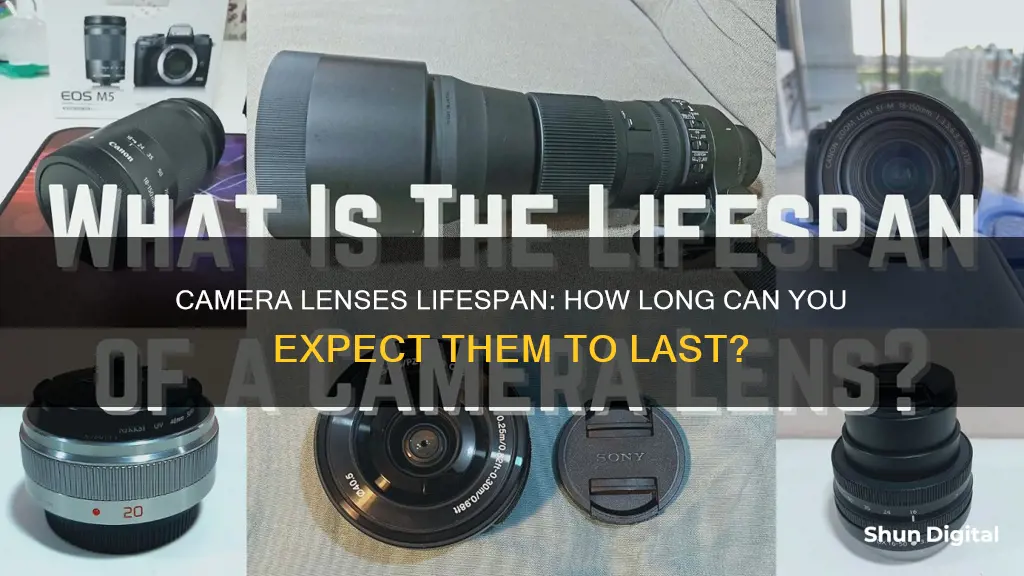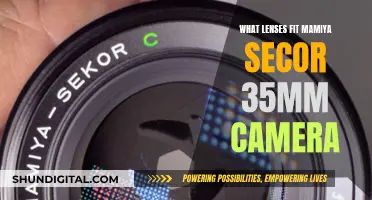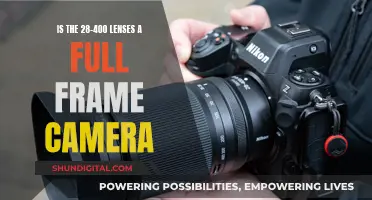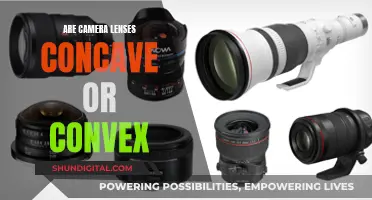
Camera lenses can last for decades if they are well-maintained and stored properly. The lifespan of a lens depends on its usage, quality, and the care taken to preserve it. High-end lenses, for instance, will typically outlast their cheaper counterparts due to the use of superior materials in their manufacturing. Additionally, the frequent attachment and detachment of lenses from the camera body can reduce the lifespan of gold-plated contacts at the rear of the lens.
Modern lenses with electronic components and autofocus motors may have a shorter lifespan than older, simpler lenses. However, with proper care, these lenses can still provide many years of service. It is worth noting that lenses with ultrasonic or piezo motors may have a limited lifespan due to the nature of their driving mechanisms.
Overall, the longevity of a camera lens is influenced by various factors, but with proper care, a lens can last for a considerable amount of time.
| Characteristics | Values |
|---|---|
| Lifespan | Decades, if properly cared for |
| Factors that affect lifespan | Usage, build quality, maintenance, storage, quality of materials, humidity, exposure to elements, age, complexity of mechanics, presence of electronics, autofocus, image stabilisation |
What You'll Learn

Camera lens shelf life
Camera lenses can last for decades if they are well-maintained and stored correctly. However, the lifespan of a lens depends on several factors, including usage, environment, and quality.
Usage
The more frequently a lens is attached and detached from a camera body, the shorter its lifespan will be. This is because the gold-plated contacts at the rear of the lens are designed for a specific number of insertions. Additionally, zooming in and out frequently may cause the glass elements to become dislocated over time.
Environment
Storing a lens in a humid environment can cause rubber parts to wear out and become sticky or non-functional. It can also lead to the growth of fungus on the lens, which can affect image quality. To prevent this, photographers can store their lenses in a dry cabinet or include silica gel packets in their camera bag to absorb moisture.
Quality
High-end lenses tend to have a longer lifespan than cheaper lenses due to the use of top-quality materials in their manufacturing. For example, high-end lenses often have a metallic casing, while cheaper lenses have a plastic body. As a result, plastic lenses are more likely to break if dropped.
Maintenance
Proper maintenance is essential to extending the lifespan of a lens. This includes regular cleaning, especially after outdoor shoots, and visual inspections for scratches, cracks, and worn-out parts. It is also important to protect the front element of the lens with a UV or clear screw-on filter.
Other Factors
The introduction of electronics and autofocus motors in modern lenses may reduce their lifespan compared to older, fully mechanical lenses. Additionally, the availability of spare parts may become an issue for older lenses, as manufacturers may discontinue support after a certain period.
How to Safely Remove and Clean Your Camera Lens
You may want to see also

Camera lens parts
Camera lenses can last for decades if they are well-maintained and stored in the right climate to prevent mould, mildew and fungus. However, the length of time they last depends on various factors, including the quality of the lens, how often it is used, and the conditions in which it is used and stored.
Lens Cap
This is the part you always forget to take off and wonder why your pictures are coming out black or why the exposure mode on your camera is reading a 20-second shutter speed. Under this cap, you will find the filter thread size printed for your lens around the actual glass of the lens (not on the outside ring).
Outside Ring
On the outside ring, closest to the front of your lens, the focal length and the widest aperture the lens is capable of will be printed. This wide ring is used to adjust the focus of your lens.
Auto/Manual Focus Switch
Usually placed just below the focus ring is a switch to toggle between automatic and manual focus of the lens. Obviously, if you have a manual focus lens, this switch won’t exist on your lens. While not shown on the diagram above, on lenses with image stabilization, there will be another switch, usually near the auto/manual focus switch. It will usually just be labelled with an “IS”.
Depth of Field/Focusing Distance
This readout tells you what distance your lens is currently focused at. This is especially helpful when you’re doing astrophotography or landscape photography and want your focus set to infinity.
Zoom Ring
If your lens zooms at all, you will have another ring (usually closer to the rear of the lens) that controls the focal length or ‘zoom’ of the lens.
Focal Length Indicator
Much like the depth of field readout, this indicator tells you what focal length you are at on your zoom lens.
Rear Lens Cap
The cap that goes on the back of your lens when you take it off your camera. It is extremely important to keep this cap secured to keep dust from getting into both your lens and your camera.
EF-S Lenses: Full-Frame Camera Compatibility Explored
You may want to see also

Camera lens wear and tear
Usage
Heavy or frequent use of a camera lens can lead to wear and tear over time. The more a lens is used, the higher the likelihood of mechanical or electronic components wearing out. This is particularly true for lenses with autofocus and image stabilization features, as the motors and electronics involved can degrade over time. Additionally, attaching and detaching the lens frequently can wear down the gold-plated contacts, reducing their lifespan.
Storage and Environmental Conditions
Improper storage of camera lenses can accelerate wear and tear. Storing lenses in humid environments can cause issues with rubber parts, autofocus systems, and the growth of lens fungus. Storing lenses in direct sunlight or high temperatures can also lead to the deterioration of rubber and plastic components. To mitigate these issues, photographers should consider using dry cabinets or silica gel packets to regulate humidity and store lenses in cool, dry locations.
Quality and Build of the Lens
The quality and build of a camera lens also play a role in its longevity. High-end lenses made with top-quality materials and metallic casings tend to have a longer lifespan than cheaper lenses with plastic bodies. More expensive lenses often have better weather sealing, protecting them from harmful environmental conditions. Additionally, older metal lenses are known for their durability and can last for decades if properly maintained.
Maintenance and Care
Proper maintenance and care can significantly extend the lifespan of a camera lens. This includes regular cleaning, protecting the lens with filters, using lens hoods, and storing lenses in padded compartments or wraps when travelling. It is also crucial to handle lenses with clean hands and avoid touching the rear element.
Common Signs of Wear and Tear
There are several indications that a camera lens may be worn out or damaged:
- Scratches on the front or back lens glass.
- Worn-out or sticky rubber parts, often due to storage in humid or hot environments.
- Autofocus issues, which can occur over time or due to heavy use.
- Problems with zooming, such as difficulty zooming in or out or a "retraction issue."
- Visible broken parts, such as cracks on lens components.
- Non-working switches, such as the auto/manual focus slider or image stabilization slider.
- Issues with lens contacts, which can cause communication errors between the lens and camera body.
- Worn-out or loose zoom rings, particularly in older lenses with push and pull zooms.
- Scratches and dents on the lens body or glass elements, indicating rough use or accidental drops.
In summary, camera lens wear and tear is influenced by a combination of factors, including usage frequency, storage conditions, lens quality, and maintenance practices. By understanding these factors and taking proper care of their equipment, photographers can extend the lifespan of their camera lenses and capture beautiful images for years to come.
Minolta Lenses: Universal Fit for Minolta Cameras?
You may want to see also

Camera lens damage
Camera lenses are delicate pieces of equipment that can be damaged in several ways. Here are some common causes of camera lens damage:
Water Damage
Water, especially non-distilled water, can be detrimental to camera lenses. While pure distilled water is a poor conductor of electricity and may not cause immediate harm, most natural water sources contain minerals, salts, and dirt, which can short-circuit electronics, leading to long-term damage. Saltwater, in particular, is highly conductive and can destroy camera gear over time. Coastal environments with salty air can also cause damage to lenses due to salt creeping into the seams.
Sand Damage
Sand, especially fine-grained sand, can easily find its way into lenses and camera bodies, causing damage to focus rings and other internal components. Even lenses marketed as "weather-proof" may not be able to withstand sandy environments. Events like the "Color Run," where coloured powder is thrown at participants, can have similar detrimental effects on lenses as sand.
Physical Impact/Dropping
Physical impact or dropping a camera lens is a sure way to cause damage. While some lenses can withstand minor falls, depending on the height and angle of impact, a single drop can often lead to costly repairs or irreparable damage.
Age and Usage
Over time, camera lenses may suffer from lubricant degradation, coating deterioration, and mechanical wear. Electronics in modern lenses, such as autofocus and image stabilisation systems, may also fail or become outdated. Frequent usage, especially in challenging environments, can accelerate these issues.
Fungus and Mould
Fungus and mould growth can occur in lenses, especially in humid climates. This can cloud the optics, reducing resolution and transmission over time, giving lenses a "vintage faded look."
Improper Care and Storage
Improper care and storage practices can increase the likelihood of lens damage. For example, stacking lenses in a camera bag, using lenses in water or sandy environments without adequate protection, touching the rear element of the lens, and not using lens caps can all contribute to potential issues.
Manufacturing Defects
In some cases, camera lenses may have inherent manufacturing defects that can lead to premature failure or performance issues.
Environmental Factors
Environmental factors, such as extreme temperatures, direct sunlight, and air pollution, can also contribute to lens damage over time.
Electronic Component Degradation
Some electronic components in modern lenses may have limited lifespans. For example, lead-free solder used in electronics can be more prone to cracking and soldering issues over time.
Incompatible Accessories
Using incompatible accessories, such as certain filters or adapters, can potentially damage a lens.
Other External Factors
Other external factors, such as sunscreen residue on hands, can also impact the longevity of lenses by degrading grips and other components.
It is important to note that proper care and maintenance can significantly extend the lifespan of camera lenses. Regular servicing, cleaning, and storing lenses in suitable conditions can help mitigate many of the potential issues mentioned above.
Lens Compatibility: Understanding Camera Lens Interchangeability
You may want to see also

Camera lens expiration
Camera lenses do not have an expiration date, but they do have a lifespan that depends on their usage and environment. If you take proper care of your camera lens, you can use it for many years without any issues. However, heavy use or improper storage can shorten its lifespan.
The lifespan of a camera lens is influenced by several factors:
- Usage: Frequent attaching and detaching of the lens from the camera body can lower the life of the gold-plated contacts at the rear of the lens. Zooming in and out frequently may also cause the glass elements to become dislocated over time. Additionally, the ribbon cable inside the lens may wear out with extended use.
- Quality: High-end lenses tend to have a longer lifespan than cheaper ones due to the use of top-quality materials in their manufacturing. For example, high-end lenses often have a metallic casing, while cheaper lenses may have a plastic body that is more prone to breaking if dropped.
- Maintenance and Storage: Proper maintenance and storage are crucial for prolonging the lifespan of a camera lens. It is recommended to clean the lens after each outdoor shoot and store it in a dry cabinet or camera bag with silica gel packets to absorb moisture, especially in humid environments.
- Age: Older metal lenses are often built to last and can be used for decades if properly maintained. However, modern lenses with electronic components may have a shorter lifespan due to the potential failure of those components over time.
- Brand and Model: Some brands and models of lenses are known for their durability, while others may have common issues that shorten their lifespan. For example, certain Canon EF lenses from the late 1980s and early 1990s have been reported to fail over the past decade.
It is worth noting that while camera lenses can last for many years, they may become outdated as new versions with improved features are released. Additionally, manufacturers may discontinue certain lens models, making it difficult to find replacement parts for repairs in the future.
Camera Contact Lenses: Fact or Fiction?
You may want to see also
Frequently asked questions
Camera lenses can last for decades if they are well-maintained and stored in the right climate to prevent mould. However, the autofocus system may become incompatible or break down with use, and the electronics in modern lenses may degrade over time.
The lifespan of a camera lens depends on its usage, quality, and how well it is maintained and stored. High-end lenses tend to have a longer life than cheaper ones as they are made with top-quality materials.
Some signs that a camera lens may be damaged or worn out include scratches on the lens glass, worn-out or sticky rubber parts, a broken autofocus system, and visible broken parts.
To test a camera lens without a camera body, you can inspect the glass elements for scratches, fungus, and water droplets, turn the zoom and focus rings to ensure smooth movement, and check the tripod mount threads and lens screws.
To prolong the lifespan of a camera lens, it is important to store it properly when not in use. This includes cleaning the lens after each use, storing it in a dry cabinet or camera bag with silica gel packets to absorb moisture, and keeping it in a cool, dry place away from direct sunlight.







